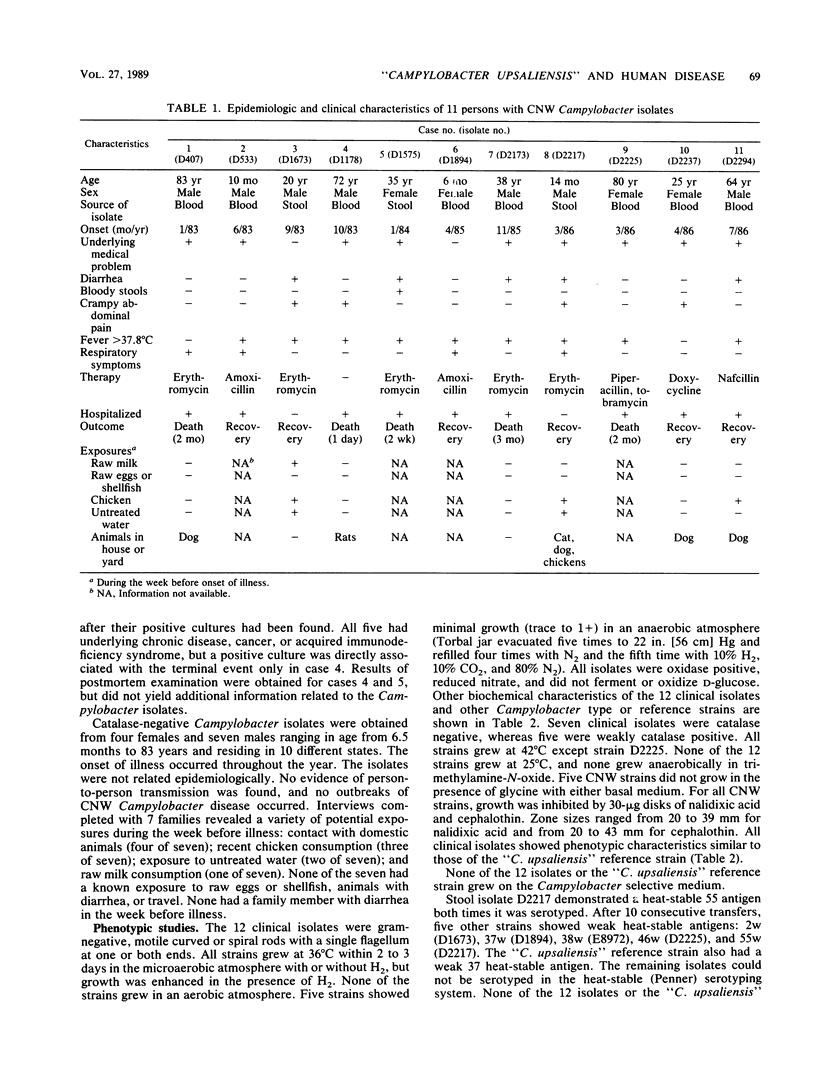Abstract
Catalase-negative or weakly positive (CNW) thermotolerant campylobacteria, first isolated from dogs in 1983, were recently recognized as a new species, "Campylobacter upsaliensis," but their association with human illness has not been established. Twelve human isolates received at the Centers for Disease Control between 1980 and 1986 were identified as CNW campylobacteria by biochemical tests, cellular fatty acid composition, and antimicrobial susceptibility patterns. Eleven CNW Campylobacter strains tested by DNA-DNA hybridization (hydroxyapatite method) were all highly related and were related to two "C. upsaliensis" strains at the species level (86% under optimal conditions and 76% under stringent conditions). Clinical information was obtained for 11 human isolates from three stool and eight blood specimens. They were isolated from four female and seven male patients 6.5 months to 83 years of age residing in 10 different states. The patients had a wide spectrum of illnesses. The stool isolates were obtained from two previously healthy persons during episodes of acute gastroenteritis and from one immunocompromised patient with persistent diarrhea and fever. The blood isolates were obtained from two infants with fever and respiratory symptoms; a young woman with a ruptured ectopic pregnancy; three elderly men with underlying chronic diseases; and two immunocompromised adults. In a bactericidal assay to assess sensitivity to serum, seven of eight blood isolates showed some resistance to killing by pooled normal human serum. These observations suggest that "C. upsaliensis" is a potential human pathogen associated with both gastroenteritis and bacteremia in normal hosts and with opportunistic infection in immunocompromised individuals.
Full text
PDF







Selected References
These references are in PubMed. This may not be the complete list of references from this article.
- BRYNER J. H., O'BERRY P. A., FRANK A. H. VIBRIO INFECTION OF THE DIGESTIVE ORGANS OF CATTLE. Am J Vet Res. 1964 Jul;25:1048–1050. [PubMed] [Google Scholar]
- Blaser M. J., Berkowitz I. D., LaForce F. M., Cravens J., Reller L. B., Wang W. L. Campylobacter enteritis: clinical and epidemiologic features. Ann Intern Med. 1979 Aug;91(2):179–185. doi: 10.7326/0003-4819-91-2-179. [DOI] [PubMed] [Google Scholar]
- Blaser M. J., Reller L. B. Campylobacter enteritis. N Engl J Med. 1981 Dec 10;305(24):1444–1452. doi: 10.1056/NEJM198112103052404. [DOI] [PubMed] [Google Scholar]
- Blaser M. J., Smith P. F., Kohler P. F. Susceptibility of Campylobacter isolates to the bactericidal activity of human serum. J Infect Dis. 1985 Feb;151(2):227–235. doi: 10.1093/infdis/151.2.227. [DOI] [PubMed] [Google Scholar]
- Brenner D. J., McWhorter A. C., Knutson J. K., Steigerwalt A. G. Escherichia vulneris: a new species of Enterobacteriaceae associated with human wounds. J Clin Microbiol. 1982 Jun;15(6):1133–1140. doi: 10.1128/jcm.15.6.1133-1140.1982. [DOI] [PMC free article] [PubMed] [Google Scholar]
- Goossens H., De Boeck M., Coignau H., Vlaes L., Van den Borre C., Butzler J. P. Modified selective medium for isolation of Campylobacter spp. from feces: comparison with Preston medium, a blood-free medium, and a filtration system. J Clin Microbiol. 1986 Nov;24(5):840–843. doi: 10.1128/jcm.24.5.840-843.1986. [DOI] [PMC free article] [PubMed] [Google Scholar]
- Kodaka H., Armfield A. Y., Lombard G. L., Dowell V. R., Jr Practical procedure for demonstrating bacterial flagella. J Clin Microbiol. 1982 Nov;16(5):948–952. doi: 10.1128/jcm.16.5.948-952.1982. [DOI] [PMC free article] [PubMed] [Google Scholar]
- Lambert M. A., Patton C. M., Barrett T. J., Moss C. W. Differentiation of Campylobacter and Campylobacter-like organisms by cellular fatty acid composition. J Clin Microbiol. 1987 Apr;25(4):706–713. doi: 10.1128/jcm.25.4.706-713.1987. [DOI] [PMC free article] [PubMed] [Google Scholar]
- Moss C. W., Kai A., Lambert M. A., Patton C. Isoprenoid quinone content and cellular fatty acid composition of Campylobacter species. J Clin Microbiol. 1984 Jun;19(6):772–776. doi: 10.1128/jcm.19.6.772-776.1984. [DOI] [PMC free article] [PubMed] [Google Scholar]
- Patton C. M., Barrett T. J., Morris G. K. Comparison of the Penner and Lior methods for serotyping Campylobacter spp. J Clin Microbiol. 1985 Oct;22(4):558–565. doi: 10.1128/jcm.22.4.558-565.1985. [DOI] [PMC free article] [PubMed] [Google Scholar]
- Roop R. M., 2nd, Smibert R. M., Johnson J. L., Krieg N. R. Differential characteristics of catalase-positive campylobacters correlated with DNA homology groups. Can J Microbiol. 1984 Jul;30(7):938–951. doi: 10.1139/m84-147. [DOI] [PubMed] [Google Scholar]
- Steele T. W., Sangster N., Lanser J. A. DNA relatedness and biochemical features of Campylobacter spp. isolated in central and South Australia. J Clin Microbiol. 1985 Jul;22(1):71–74. doi: 10.1128/jcm.22.1.71-74.1985. [DOI] [PMC free article] [PubMed] [Google Scholar]
- Tauxe R. V., Patton C. M., Edmonds P., Barrett T. J., Brenner D. J., Blake P. A. Illness associated with Campylobacter laridis, a newly recognized Campylobacter species. J Clin Microbiol. 1985 Feb;21(2):222–225. doi: 10.1128/jcm.21.2.222-225.1985. [DOI] [PMC free article] [PubMed] [Google Scholar]


